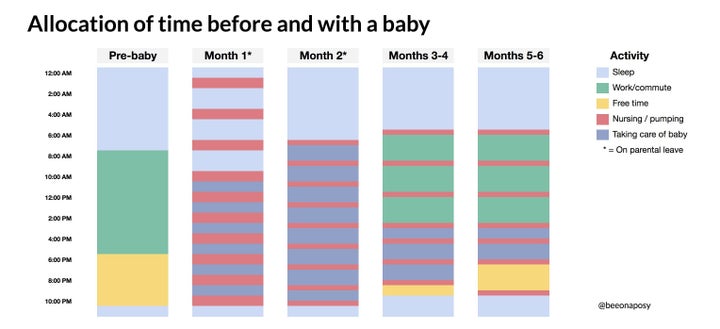
Anyone who has kids, or who spends time with anyone who has kids, knows how busy and overwhelmed parenthood can be.
But for parents, explaining the shift that happens after a baby is born is often relayed in frazzled, anecdotal stories about sleepless nights, rather than cold, hard graphs.
Enter Caitlin Hudon.
Earlier this year, the Austin, Tx.-based data scientist was struggling to explain just how significantly her days had changed since becoming a mom. So she turned to data.
“I tried to explain just how much having a baby (and breastfeeding) had changed my time, and found that describing it wasn’t nearly as impactful as seeing the change visually,” Hudon told HuffPost Canada in an email.
Data visualization is part of her job, she explained, so she’s used to communicating information that way.
Hudon tweeted out her chart, which is clearly resonating with parents: It’s been “liked” almost 3,000 times at the time of this post’s publish. (See a larger version here.)

The chart demonstrates how an even spread of sleep, work, commute, and free time pre-baby gives way to time spent on just three activities post-birth: sleep, nursing, and taking care of the baby. For the first two months, there’s nothing else.
In the first month, “feeding a baby is literally a full-time job,” Hudon wrote on Twitter.
Free time comes back — ever so slightly — in months three and four. But even then, it’s just the tiniest sliver of her day.
There’s been more open discussion among birthing parents lately about the boredom and isolation that can accompany maternity leave.
“The loneliness of new motherhood can stem from a variety of sources, but most commonly, it is associated with feelings of disconnect from one’s past life,” University of Toronto law student Sophie Beaton wrote in her recent essay “Never Alone but Always Lonely: The Social Isolation of Being a New Mother.”
Watch: The truth about getting sleep with a newborn. Story continues after video.
For Hudon, things started to get more balanced by months five and six. That’s when she finally got into a “groove,” and it was during that free time that she was able to put the chart together.
Spending time alone, without the burdens of working, being social or having to keep a tiny human alive, has a ton of benefits. It can help process emotion, benefit relationships and increase creativity, according to the New York Times. But that’s obviously not accessible to a lot of people on parental leave.
Hudon’s experience is obviously a personal one, and mileage varies massively when it comes to a baby’s growth, routine and especially sleep schedule. But it’s always refreshing to see moms who are open about their parenting experience, and who have creative ways to show it.
Also on HuffPost: